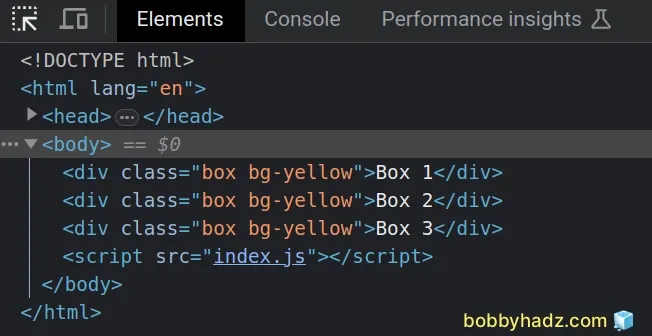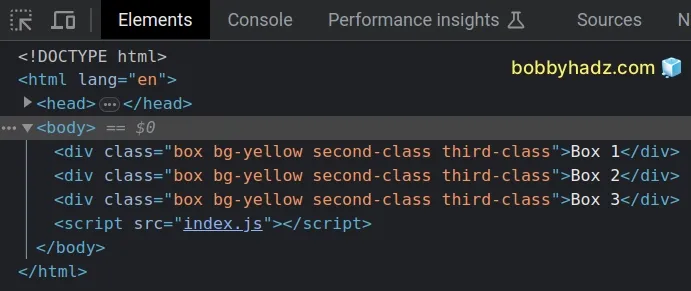Add a class to multiple Elements using JavaScript
Last updated: Mar 5, 2024
Reading time·3 min

# Add a class to multiple Elements using JavaScript
To add a class to multiple elements:
- Select the elements using the
document.querySelectorAll()method. - Use a
for...ofloop to iterate over the collection of elements. - Use the
classList.addmethod to add a class to each element.
Here is the HTML for the examples.
<!DOCTYPE html> <html lang="en"> <head> <meta charset="UTF-8" /> <title>bobbyhadz.com</title> <style> .bg-yellow { background-color: yellow; } </style> </head> <body> <div class="box">Box 1</div> <div class="box">Box 2</div> <div class="box">Box 3</div> <script src="index.js"></script> </body> </html>
And here is the related JavaScript code.
const boxes = document.querySelectorAll('.box'); for (const box of boxes) { box.classList.add('bg-yellow'); }

We used the document.querySelectorAll()
method to select all elements with a class of box.
You could also use the document.getElementsByClassName method to achieve the
same result.
const boxes = document.getElementsByClassName('box'); for (const box of boxes) { box.classList.add('bg-yellow'); }

The getElementsByClassName method takes a class as a parameter and returns a
collection containing the elements with the given class.
The
for...of
statement is used to loop over iterable objects like arrays, strings, Map,
Set and NodeList objects and generators.
On each iteration, we use the classList.add() method to add a class to the element.
# Adding multiple classes to multiple elements
You can pass as many classes to the add() method as necessary.
const boxes = document.querySelectorAll('.box'); for (const box of boxes) { box.classList.add( 'bg-yellow', 'second-class', 'third-class' ); }

Similarly, if you need to remove one or more classes, you can use the
classList.remove() method.
const boxes = document.querySelectorAll('.box'); for (const box of boxes) { box.classList.add( 'bg-yellow', 'second-class', 'third-class' ); box.classList.remove( 'second-class', 'third-class' ); }
If any of the classes don't exist on the element, they get ignored.
# Add class to elements with multiple, different selectors
The querySelectorAll method takes one or more selectors, so we are able to
select elements with multiple different classes, ids, etc.
Here is an example that uses the method to get a collection of elements with 3 different classes.
<!DOCTYPE html> <html lang="en"> <head> <title>bobbyhadz.com</title> <meta charset="UTF-8" /> <style> .bg-yellow { background-color: yellow; } </style> </head> <body> <div class="box1">Box 1</div> <div class="box2">Box 2</div> <div class="box3">Box 3</div> <script src="index.js"></script> </body> </html>
And here is the related JavaScript code.
const boxes = document.querySelectorAll('.box1, .box2, .box3'); for (const box of boxes) { box.classList.add('bg-yellow', 'second-class', 'third-class'); box.classList.remove('second-class', 'third-class'); }
We passed 3 different selectors to the querySelectorAll method by separating
them with commas.
You could pass an id to a method by prefixing the id value with a #, e.g.
#my-id.
# Add a class to multiple Elements using forEach()
The previous code samples used the for...of loop to add a class to multiple
elements, however, you can also use the
NodeList.forEach()
method.
<!DOCTYPE html> <html lang="en"> <head> <meta charset="UTF-8" /> <title>bobbyhadz.com</title> <style> .bg-yellow { background-color: yellow; } </style> </head> <body> <div class="box">Box 1</div> <div class="box">Box 2</div> <div class="box">Box 3</div> <script src="index.js"></script> </body> </html>
And here is the related JavaScript code.
const boxes = document.querySelectorAll('.box'); boxes.forEach(box => { box.classList.add('bg-yellow'); });
The function we passed to the NodeList.forEach() method gets called with each
element in the list.
On each iteration, we use the classList.add() method to add a class to the
element.
An important thing to note is that we used the querySelectorAll method to
select the DOM elements.
The querySelectorAll method returns a NodeList, whereas the
getElementsByClassName method returns an HTMLCollection.
If you use the getElementsByClassName method, convert the collection to an
array before calling forEach().
const boxes = Array.from(document.getElementsByClassName('box')); boxes.forEach(box => { box.classList.add('bg-yellow'); });
The Array.from() method creates a new, shallow-copied array from the provided iterable.
We had to convert the HTMLCollection to an array to be able to use the
Array.forEach() method.
The for...of loop from the previous examples can be used with any iterable,
including NodeLists, HTMLCollections and arrays.
# Additional Resources
You can learn more about the related topics by checking out the following tutorials:

